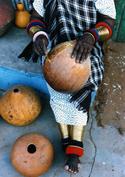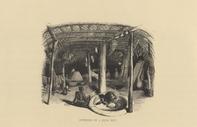
In South Africa, women are the main custodians of gourds, more commonly known as calabashes, growing them as a source of food and medicinal cures, and preparing them for use as containers, and for other purposes. It is generally accepted that these bottle gourd (Lagenaria siceraria) are indigenous to Africa.
Once harvested, the gourds are stored for at least six months to allow them to dry out before they are cut open and prepared for domestic use.
Rural communities also commonly eat the leaves and green fruit of gourds as vegetables and snack on their seeds. Oil can also be extracted from these seeds. Among Zulu-speakers, infusions made from two handfuls of a mixture of leaves or roots with those of Bidens pilosa (blackjack) are taken for stomach aches or administered as enemas.

In Natal and the Zulu Kingdom, milk was soured in gourds kept at the back of the umsamo (hearth) of homesteads before being consumed from clay pots. The milk was poured into these containers through a round opening cut into the narrow neck.
A small hole drilled into the bottom of the gourd, which was fitted with a wooden plug, was used to drain the thin watery whey from the clotted souring milk curds. They could also be sucked out through a reed.
Among the Bhaca, anyone who was regarded as ritually impure such as a menstruating woman or boys going through puberty rights were prohibited from attending to milk calabashes even if the sour milk overflowed while fermenting.

Spoons and ladles made from gourds are used for scooping water, milk or beer from one container into another. They were also used as spoons for eating and drinking. During the 19th century, people living in the Zulu kingdom close to the king’s home, thanked him after the annual harvest by presenting him with beer.
When this gift was carried to the royal homestead, the procession would be headed by a young man who carried a calabash of water, not beer, to show that the beer they were bringing was clean and that various taboos had been observed in preparing it.